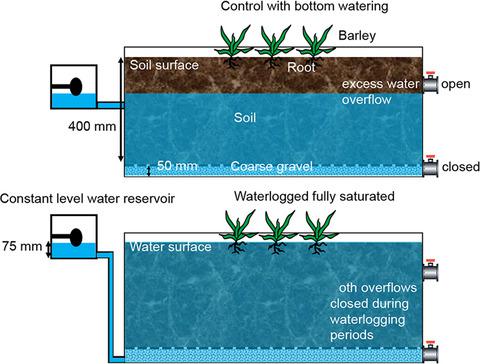当前位置:
X-MOL 学术
›
Food Energy Secur.
›
论文详情
Our official English website, www.x-mol.net, welcomes your
feedback! (Note: you will need to create a separate account there.)
Genetic factors increasing barley grain yields under soil waterlogging
Food and Energy Security ( IF 4.0 ) Pub Date : 2020-08-08 , DOI: 10.1002/fes3.238 Ke Liu 1, 2 , Matthew Tom Harrison 2 , Ahmed Ibrahim 2 , S. M. Nuruzzaman Manik 2 , Peter Johnson 2 , Xiaohai Tian 1 , Holger Meinke 2 , Meixue Zhou 1, 2
Food and Energy Security ( IF 4.0 ) Pub Date : 2020-08-08 , DOI: 10.1002/fes3.238 Ke Liu 1, 2 , Matthew Tom Harrison 2 , Ahmed Ibrahim 2 , S. M. Nuruzzaman Manik 2 , Peter Johnson 2 , Xiaohai Tian 1 , Holger Meinke 2 , Meixue Zhou 1, 2
Affiliation

|
In‐crop soil waterlogging can be caused by extreme rainfall events, high ground water tables, excessive irrigation, lateral ground water flow, either individually or in concert, and together these factors inhibit potential grain yields. However, the extent to which yield is influenced by the timing and duration of waterlogging relative to crop phenology is unknown. To investigate this, we conducted a range of waterlogging treatments on modern barley genotypes differing in their waterlogging tolerance, with tolerance conferred through aerenchyma formation under oxygen deficit conditions. Experiment 1 was conducted in a controlled environment using four waterlogging treatments: waterlogging at Zadoks stage (ZS) 12.5 for 1 or 2 months (WL1 and WL2, respectively), waterlogging at ZS 15 for 2 months (WL3), and waterlogging initiated 1 day before heading for 15 days (WL4). Experiment 2 was conducted in the field with WL2. Averaged across experiments, yield was reduced by 35% in W1 to 52% in WL3 due to fewer spikes/m2 and kernels/spike. WL4 had the greatest impact on yield (70% reduction) due to its effect on spikelet fertility and grain filling. Phenology was delayed 1–8 ZS at the end of waterlogging treatments, with the waterlogging‐susceptible cultivar Franklin showing the greatest delays, and waterlogging tolerant genotypes (Macquarie+, TAMF169) capable of aerenchyma formation under waterlogging having the least delays (0–4 ZS). Genotypes with aerenchyma formation QTL (Macquarie+) showed nonsignificant yield reduction compared with nonwaterlogged controls, preventing 23% yield loss under early phenological waterlogging stress. Late growth stage waterlogging substantially reduced average final grain yield by 70%.
中文翻译:

淹水条件下大麦籽粒增产的遗传因素
极端降雨事件,地下水位高,灌溉过多,横向地下水流量(单独或共同作用)可能导致作物土壤内涝,这些因素共同抑制了潜在的谷物产量。然而,相对于作物物候,产量受淹水时间和持续时间的影响程度尚不清楚。为了对此进行研究,我们对不同的现代大麦基因型进行了一系列的涝渍处理,这些基因型具有不同的涝渍耐受性,并且在缺氧条件下通过通气孔形成赋予了耐受性。实验1是在受控环境中使用四种浸水处理进行的:在Zadoks阶段(ZS)12.5浸水1或2个月(分别为WL1和WL2),在ZS 15浸水2个月(WL3),并在前进15天(WL4)之前1天开始进行涝灾。实验2是使用WL2在现场进行的。各个实验的平均值是,W1中的产量降低了35%,而WL3中的产量降低了52%,这是因为每米峰值2和内核/峰值。WL4由于对小穗肥力和籽粒充实的影响,对产量的影响最大(降低70%)。在淹水处理结束时,物候被延迟1–8 ZS,其中对淹水敏感的富兰克林品种表现出最大的延迟,并且在淹水条件下能够形成气孔的耐水淹基因型(Macquarie +,TAMF169)具有最小的延迟(0–4 ZS) )。与未淹水的对照相比,具有气孔形成QTL(Macquarie +)的基因型表现出不显着的产量下降,可防止在早期物候性淹水胁迫下23%的产量损失。生育后期的涝渍使平均最终谷物收成大大降低了70%。
更新日期:2020-08-08
中文翻译:

淹水条件下大麦籽粒增产的遗传因素
极端降雨事件,地下水位高,灌溉过多,横向地下水流量(单独或共同作用)可能导致作物土壤内涝,这些因素共同抑制了潜在的谷物产量。然而,相对于作物物候,产量受淹水时间和持续时间的影响程度尚不清楚。为了对此进行研究,我们对不同的现代大麦基因型进行了一系列的涝渍处理,这些基因型具有不同的涝渍耐受性,并且在缺氧条件下通过通气孔形成赋予了耐受性。实验1是在受控环境中使用四种浸水处理进行的:在Zadoks阶段(ZS)12.5浸水1或2个月(分别为WL1和WL2),在ZS 15浸水2个月(WL3),并在前进15天(WL4)之前1天开始进行涝灾。实验2是使用WL2在现场进行的。各个实验的平均值是,W1中的产量降低了35%,而WL3中的产量降低了52%,这是因为每米峰值2和内核/峰值。WL4由于对小穗肥力和籽粒充实的影响,对产量的影响最大(降低70%)。在淹水处理结束时,物候被延迟1–8 ZS,其中对淹水敏感的富兰克林品种表现出最大的延迟,并且在淹水条件下能够形成气孔的耐水淹基因型(Macquarie +,TAMF169)具有最小的延迟(0–4 ZS) )。与未淹水的对照相比,具有气孔形成QTL(Macquarie +)的基因型表现出不显着的产量下降,可防止在早期物候性淹水胁迫下23%的产量损失。生育后期的涝渍使平均最终谷物收成大大降低了70%。











































 京公网安备 11010802027423号
京公网安备 11010802027423号